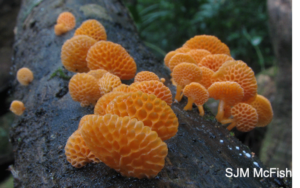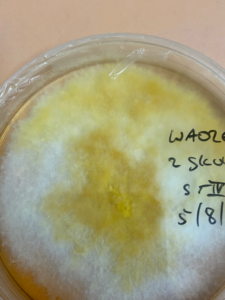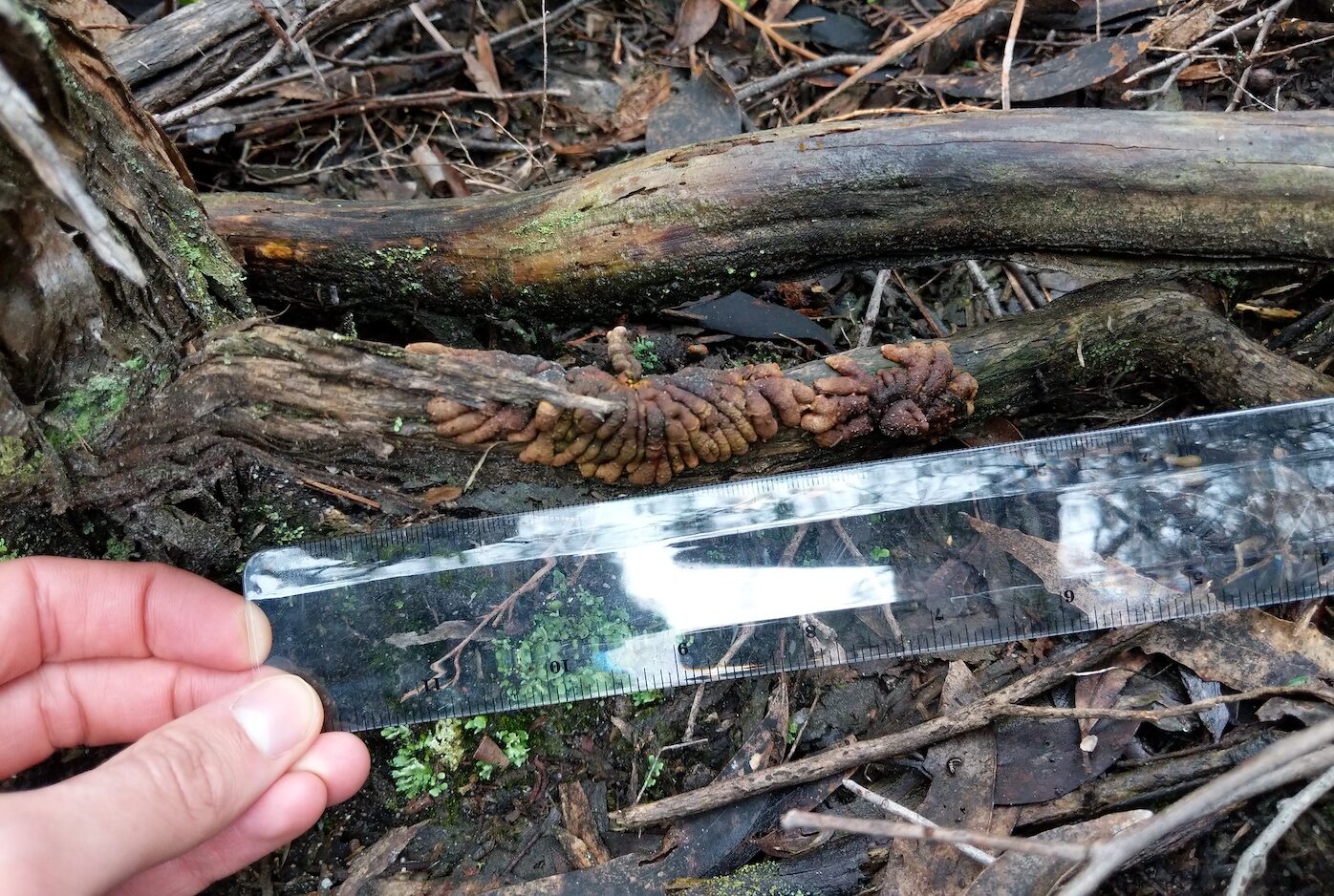Fungal enthusiasts should be heartened to hear that work continues on conserving the threatened fungus Tea-tree Fingers (TTF, Hypocreopsis amplectens). TTF is an unusual fungus as it is a mycoparasite of wood rot fungi Hymenochaetopsis and Hymenochaete species and possibly others in the family Hymenochaetaceae.
By Sapphire McMullan-Fisher
Thanks to efforts in July 2019 during the Australian Red List workshop, TTF is now globally considered among the most threatened fungi in Australia. It has an International Union for Conservation of Nature conservation status of Critically Endangered due to the severe fragmentation of TTF populations and the continuing decline of mature individuals. The small surviving populations in conservation reserves face many threats including fire, habitat degradation and destruction, and drying vegetation types with a warming climate.

The Royal Botanic Gardens Victoria (RBGV) was able to get two years funding for research into TTF. The ‘Conservation research for Tea-tree Fingers’ project aims to build on existing knowledge and resources to produce research on the biology of H. amplectens that will inform management of the species. We will identify the host fungus of tea-tree fingers, investigate genetic variation within and among populations, characterise its microhabitat and follow the development of the fungus and its host. In addition, we aim to secure pure cultures of the fungus and its host to facilitate experiments on ex situ conservation and translocation, should these approaches become necessary.
As part of the RBGV surveys into TTF likely habitat, a population was discovered at the Gurdies in July 2020. The Gurdies is a patch of vegetation between the Nyora and Grantville sites. The Gurdies has been surveyed without success in the past by a walking group from the Victorian National Parks Association in 2016-17. The new population also added a new plant host to the list with Prickly Broom-heath (Monotoca scoparia). The other common host plants species include: Prickly Tea-tree (Leptospermum continentale), Silky Tea-tree (L. myrsinoides) and Yarra Burgan (Kunzea leptospermoides). Some historical records include likely plant hosts as Tea-tree (Leptospermum scoparium), Scented Paper Bark (Melaleuca squarrosa) and Silver Banksia (Banksia marginata).
Populations at Nyora, Grantville and Launching Place all had living individuals of TTF in 2020. The Launching Place population is decreasing as the branches that supported individuals since 2016 are nearly gone from decay processes. Work is needed to understand the dynamics of falling fine woody branches which the host fungi favour. Recently fallen branches only survive a few years, so whether or not there is a steady supply of branches will have consequences for living populations.
Unfortunately, the invasive weedy fungus Favolaschia calocera was recorded by the FNCV fungi group surveys at the Wanderslore site in 2019 and Adams Creek site near Nyora in February 2021. There is the risk that this will also reduce the available branches for TTF and its host fungus. Favolaschia calocera produces abundant airborne spores so clean everything you handle if at contaminated sites like hats, water bottles, phones, shoes etc. Never go from contaminated sites to clean sites and plan your visits to start at the least disturbed sites. Learn more here.

Other threats to populations include the predation of TTF sporebodies which has been observed across most sites since 2016. Fire is an increasing threat to all sites over the last few years, with the Grantville populations being threatened by a fire that got to within 500m in February 2019. Removal of habitat is also a threat with applications to remove vegetation adjoining the Adams Creek Conservation Area where one of the populations is holding on. Degradation of habitat is also likely to be occurring with weeds and deer damage increasing at sites. Horse dung is unfortunately at these sites and is a source of weeds and excessive nutrients for the indigenous plants and fungi. The Gurdies site was also recently threatened by an illegal “bike” course being made in the reserve.
The same fruiting body a month apart. Apparently Tea-tree Fingers is delicious to arthropods! (Photos M Amor)
So far the RBGV conservation team have been successful in culturing the host fungus Hymenochaetopsis sp. from tissue samples of TTF. Samples in the past were assumed to be Hymenochaete as this is the host fungus genus of the northern hemisphere Hypocreopsis species. We unfortunately have not yet been successful in obtaining a TTF culture so work continues.

Fungimap has had a long involvement with collecting data about TTF in the Fungimap database and more recently with a field guide to surveying for it and understanding its plant hosts with a project in 2016. Fungimap and other volunteers including SPIFFA have been looking for it across sites over the years. Survey efforts in 2016-2018 at the site at Greens Bush on the Mornington Peninsula showed that this population is likely extinct as it has not been seen since 2002. There were also surveys without finding this population by John and Val in 2007.
We have updated the Tea-tree Fingers booklet so please download it here.
We hope that people who are carrying out fungal surveys in possible Tea-tree Fingers habitat record absence or zero data using the Biocollect project ‘Lost fungi Australia’. Knowing that people have looked but not found TTF also helps our understanding of its biology. Looking in likely habitat is the best way to find new populations. The listed Ecological Vegetation Classes (EVCs) for TTF populations in Victoria are: Lowland forest, Heathy woodland, Damp heathy woodland and possibly Riparian thicket and Damp heathland.
For those readers who are in NSW, there have also been sightings of TTF in the last decade from the New England area in northern New South Wales. It has also been found on the South Island of New Zealand in just two sites 100km apart in Klondyke Corner, Arthur’s Pass, and Hanmer Springs. We encourage everyone to record fungi in their local areas using systems like iNaturalist which share research grade data with our biodiversity tools like the Atlas of Living Australia.



